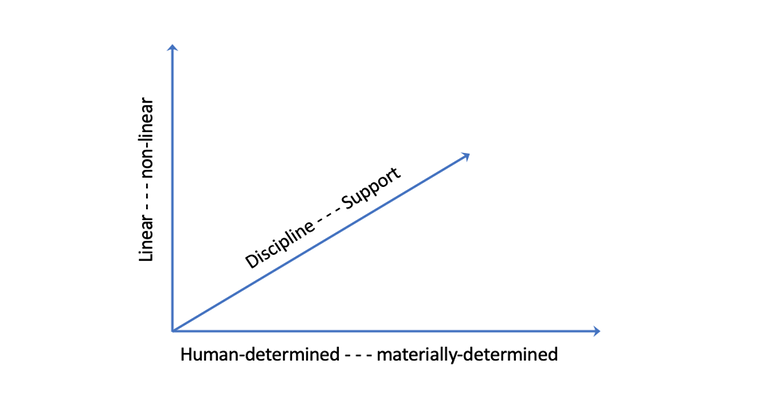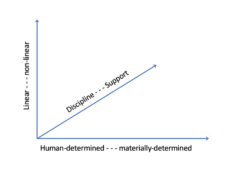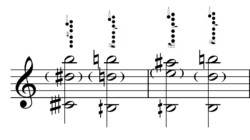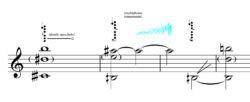Axes of Composition

How can we break down and understand the possible ways in which we might compose with the material agency* of the clarinet? [* Our use of agency is grounded in Andrew Pickering’s usage in The Mangle of Practice (1995). He describes the interactions between people and material objects as being a ‘dance of agency’ between the human intentions and the material, where they both alternate 'resisting' and 'accommodating' each other. This is a key concept for the project.]
That is to ask , how might we map out the complex and multiple ways in which compositional decisions and ideas give rise to different types of material interaction between player and clarinet?
One way to approach this problem is to understand how a specific compositional idea around material agency might be taken to its extreme. From one extreme we can create a spectrum or axis, by imagining an opposite extreme. This research project can be (simplistically) described as creating strategies for composing music where the material agency of the instrument leads the player. In order to do this, it is crucial to understand to what extent a performance/piece is led by material agency or human agency. How are compositional and performance decisions taken in relation to this? Does the clarinet decide or does the player? We might then think of the following axis as overarching the project:
Material Agency ------------------------------------ Human Agency
On this axis, the ‘Material Agency’ extreme might be imagined as the player being completely (inhumanly) neutral, allowing the material behaviour of the clarinet to emerge. This situation is not likely in reality, but it presents a useful vanishing-point to aim for. The ‘Human Agency’ extreme, on the other hand, is equally unlikely but might be imagined as an impossibly perfect clarinet designed to always support the player’s intentions; without ever producing squeaks or splits. Crucially, the extremes of an axis are rarely the situations we as composers work with. The real site of practice in this project takes place between the extremes, where opposing sides have to interact-with and accommodate-to each other, the human/material assemblage.
This post proposes a series of axes. Before we look at the proposed axes, we need to nuance the picture somewhat by looking at the practicalities, and clarifying our terms:
- Fundamental to the project is the position that any interaction between player and clarinet is an interaction between the material agency of the clarinet and the agency of the player. As soon as the player initiates in air-flow into the instrument, the clarinet’s material agency is then shaping that energy into sound. Material agency is always present, the question for us as composers is to what extent is the performer disciplining that agency, and what is it in the phase space of that specific instrument configuration (clarinet fingering) that provides more (or fewer) divergent paths onwards.
- The interaction of human and material agency is necessarily performative and situated: see Lucy Suchman’s Plans and Situated Actions. It happens in the moment but influenced by plans: i.e. what the performer intends to do ahead of time—not necessarily far ahead, but further than the moment—which in most cases will derive from score instructions (not necessarily notation).
- This work is largely theoretical at the moment. Some of these axes have been applied in compositions, and some of these have arisen from discussions but not been tried out practically yet. The spaces relate to a broader theoretical conversations about the player–instrument assemblage, and the relationship between materiality and phenomenology in this project.
Axes of compositional thought

- Support/Responsive-Listening vs Discipline/Corrective-Listening
- This axis describes the extent to which agency is associated with either the player or the instrument in-the-moment. Since the player must provide air/energy for the instrument to do anything, this is not directly an axis of material vs human agency, but rather asks what does the human do with their (necessary) agency. Whether the human is disciplining the instrument by imposing a specific musical image on the instrument (e.g. a C4 pitch, or a specific balance of multiphonic partials), or supporting what emerges from the instrument with a minimum of intervention(e.g. an unstable multiphonic gives rise to an unpredictable sounding outcome which requires support from the player to continue.
- We can also read this axis in terms of the types of listening that support and discipline produce, with the axis running from corrective-listening to responsive-listening. Of course, listening happens in all musical situations but can be used differently by the player. We can draw a difference between:
- ‘corrective listening’: listening that ensures correct actualisation of some externality such as a notational or mental images.
- ‘responsive listening’: listening that searches for something to respond-to.
- In the middle of this axis, we might find examples of open notation, where responsive and corrective modes of listening are in dialogue.
- This axis raises all sorts of interesting questions about what the extremes of material-agency can look like given that clarinet performance always requires some level of intention on the part of the player. There’s no ‘neutral’ option where the player simply activates the instrument and lets it do ‘its own thing’. There must be some choices made by the player about breath pressure/speed/embouchure etc, however, the player can sometimes choose to deliberately avoid centering this too specifically, and wait and see what emerges. Equally, the extreme end of human-agency still needs to work with the clarinet’s agency: even the most finely controlled playing contains elements of risk where the material agency ‘pops out’.
- For relatively inexperienced players, support is limited because they can only support the strongest resonances of the instrument; any given fingering configuration offers only a few possible strong pitches, and any changes to embouchure etc. tend to result in undisciplined (and uncontrolled) material agency (squawks and squeaks!). More experienced players can depart from strong resonances and explore positions between these to find what else can be supported. As the same time, an experienced player is trained to reproduce a specific set of resonances of the clarinet, this embodied technique can get in the way of an open material exploration of the instrument.

- Human-determined vs materially-determined
- This axis relates to the linear/non-linear axis below, but applies to the level of the event. It describes the extent to which the progression of events (or within a phrase/section/piece) are determined by the performer/composer, or by material agency. On one end of the axis, we might imagine common-practice notated music, where the progression of individual sounding events is determined entirely by a score imposing human agency on the instrument. On the other end of this axis, we might conceive of a situation where the unfolding of the music in time is entirely at the control of material agency; where the clarinet ‘decides what happens next’.
- This axis is strongly related to the axis above since without material agency in a given moment we can’t have material agency determining event progression. Of course human agency cannot be completely relegated because the more materially-determined end of the axis still relies ultimately on the human choosing to support the material agency rather than disciplining it.
- This axis also relates to the linear/non-linear axis below, because non-linear structures can emerge from material contingency at the event level.

- Structural Procedure vs Structural Indeterminacy (Linear vs Non-Linear)
- This axis describes the level of structural indeterminacy in a section/piece; which may or may not be explicitly related to materiality. The procedural end of the axis might describe a score where the structuring of material and sections is entirely determined and must be followed exactly by the player. The indeterminate end of the axis might describe free improvisation, where the structuring of events and sections is entirely spontaneous or responsive. Somewhere in the middle of the axis we might find performative situations where the player — or instrument — has some choice over the way in which the structure of a piece unfolds.
- This axis describes agency happening at the level of the section/piece rather than agency on the event-level of material interaction.
- Towards the non-linear end of the axis, there should be more interaction between structure and event. This can be intertwined with the above axis where the structure unfolds based how material-agency interactions unfold on an event level. Having said this, it is also possible to have situations of material agency contained within a linear structure, and non-linear structures with no material-agency.
These three axes might look something like this as a 3D space, where the origin can be imagined as a piece of common-practice notated Western music. In this visualisation any movement away from the origin means a ceding of agency to the material in some way: except for the linear/non-linear axis which is not explicitly material.

Fig.1: Axes of composition
A composition placed anywhere on the axis of determination could have different levels of discipline or support. Here's three examples; described first, then demonstrated in notations below:
- Ex.1: A piece where the multiphonics are specifically notated and their sequence is determined by the notation (which directs human agency with no influence from material agency; strong discipline).
- Ex.2: A piece where multiphonics use tablature or graphic notations alongside the explicit instruction to support emergent sounds. This piece is still strongly human-determined in its unfolding but with more material agency, requiring more support. The graphic (blue) is interesting here as it would balance corrective listening (aiming to correctly match the graphic’s shape/intensity) with a responsive listening to support emergent sounds.
- Ex.3: A piece where the human agency is significantly underdetermined, with support of emergent sounds driving the unfolding of each event. Here the human control of the instrument is firmly towards the support end of that axis, while the determination axis is balanced between human agency on an event (bar-by-bar) level, but material agency within events. Note that all agency here is constrained by the score instructions
Note that these are all still linear pieces where events unfold one after the other, so the linearity axis is not even in play here. We could introduce elements of non-linearity by having events fold back on themselves (for reasons that could be material or non-material) or having several possible streams which are all contingent on the outcome of previous events: e.g. if a multiphonic collapses to a single pitch then X or if not then Y.

Ex.1

Ex.2

Ex.3
In applying these axes to composition, a few general thoughts:
- These spaces are as much tools for analysis as they are strategies for composing.
- The axes can be thought of as containing points to move between OR constructing continuous spaces to occupy and explore.
- The term ‘spaces’ is used to mean any points or divisions along the axis.
- Spaces along an axis could be applied as the limits of an entire piece OR a piece could be made from multiple spaces used in sequence or overlaid in different ways.
- ‘Studies’ might be explorations of individual spaces, or moving procedurally along one axis.
- This reduction to axes brings with it some interesting questions of scale: levels of moment, event/note, phrase, section, or piece.
- Some axes work better at the level of the event, that is a single note or sustained sound.
- Some axes are only meaningfully applicable at larger structural levels.
- Some work across several levels.
- The description of these axes focusses on their extremes, but of course most applications of these will be more tempered. That said, it’s very productive to think what those extremes might look like, whether or not they’re realisable.
****
